| Acer palmatum 'Bihou' | USDA Zone: 5-8 |
Bihou Japanese Maple is primarily valued in the landscape for its interesting and distinctive form. It has attractive forest green foliage with hints of chartreuse which emerges pink in spring. The serrated pointy palmate leaves are highly ornamental and turn an outstanding gold in the fall. The smooth yellow bark and coral-pink branches are extremely showy and add significant winter interest.
A beautiful small tree featuring glowing yellow bark with an orange tinge in winter; new leaves emerge pink in spring, turn chartreuse, then emerald green in summer, finishing with a fall display of gold; demands a place of eminence in the garden.
Bihou Japanese Maple is recommended for the following landscape applications;
- Accent
- Mass Planting
- Hedges/Screening
- General Garden Use
- Container Planting
Attractive Bark
Fall Color
Year-round-Interest
Common Name: Japanese Maple
|
Key Feature
|
Light Needs | Landscape Uses |
 |
 |
|
|
|
|
| More About Bihou Japanese Maple |
| Height: 15-20 ft |
Spread: 12-15 ft |
|
Bihou Japanese Maple does best in full sun to partial shade. It prefers to grow in average to moist conditions, and shouldn't be allowed to dry out. It is not particular as to soil pH, but grows best in rich soils. It is somewhat tolerant of urban pollution, and will benefit from being planted in a relatively sheltered location. Consider applying a thick mulch around the root zone in winter to protect it in exposed locations. Bihou Japanese Maple is a fine choice for the yard, but it is also a good selection for planting in outdoor pots and containers. Because of its height, it is often used as a 'thriller' in the 'spiller-thriller-filler' container combination; plant it near the center of the pot, surrounded by smaller plants and those that spill over the edges. It is even sizeable enough that it can be grown alone in a suitable container. Note that when grown in a container, it may not perform exactly as indicated on the tag - this is to be expected. Also note that when growing plants in outdoor containers and baskets, they may require more frequent waterings than they would in the yard or garden. Be aware that in our climate, most plants cannot be expected to survive the winter if left in containers outdoors, and this plant is no exception. NOTE: Some flowers and plants may be harmful or poisonous to people or pets if touched or ingested. If you require more information before placing an order, please let us know in advance. |









